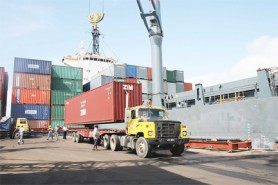Chris Fernandes, Chairman and Chief Executive Officer of the country’s leading shipping company has again alluded to the need for the country to invest in improving local port facilities which can continue to serve Guyana well providing such works are undertaken.

Fernandes who heads the John Fernandes Group of Companies is quoted as saying in an interview published in the 2010 issue of the Georgetown Chamber of Commerce’s Investor’s Guide To Doing Business In Guyana that “the present port facilities in Georgetown are in need of a significant capital investment to make them more efficient.” According to Fernandes “providing this is done the present port can continue to adequately satisfy the needs of our local economy in the short and medium term.”
Fernandes’ comment on the need to address the state of Georgetown’s port facilities follows a similar observation he made to this newspaper during an interview late last year. Then, the business executive alluded to what he described as “the historic challenges” associated with the effective functioning of the harbour and the impact on the economy. Fernandes said then that the state of the harbour does not allow ships leaving Port Georgetown to move the volume of cargo they are capable of because of the heavy silting in the channel. He noted then that Port Georgetown played a pivotal role in the buoyancy of the Guyana economy since it attracted revenues accruable from Value Added Tax and duties in excess of $12 billion annually.
In his interview with the Stabroek Business Fernandes had said that work aimed at enhancing the draught, safety of the harbour would require “millions of US dollars”. Fernandes said then that he was aware of ongoing discussions between the Ministry of Works and the Guyana Shipping Association on the idea of public/private sector management of Port Georgetown aimed at ensuring the “sustained efficiency of the port”. In his interview with the GCCI’s Investor’s Guide Fernandes also said that there was “an urgent need” to upgrade the vessels that “supply our local pilot service, surveying, buoy tendering and dredging.” Fernandes added that the low maximum draft permitted for vessels entering and leaving the port is “the main hindrance” to the efficiency of Port Georgetown.

According to Fernandes, the existing port can continue to adequately provide for the needs of the local economy in the short and medium term since “our population has remained constant over the last 50 years and our exports have experienced very modest growth and up to this point economical development has been slow.” He added however that if these parameters are changed by the road link established with Brazil “there will be a need for a deep-water harbour to cater for the upsurge in cargo movement in the medium and long term.”
An Inter-American Develop-ment Bank (IDB) study published late last year cited port-related inefficiencies as a contributing factor to high freight costs for exports to the United States from the hemisphere. The study, put freight costs of Guyana’s exports to the US at 12.4 per cent, the highest in the Caribbean, adding that if freight charges are to be reduced governments needed to undertake significant investments in port improvement including the dredging of channels to allow for larger vessels with lower operating costs to enter their ports.









